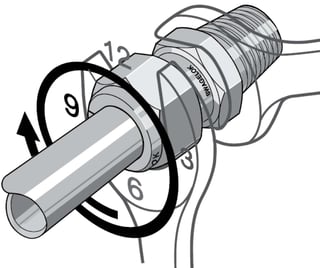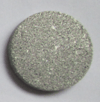
Congratulations! You've just purchased the most inert tubing available. You're looking forward to getting sample data quickly and accurately or being rid of that nagging corrosion problem. All you have to do is install the tubing and ...... Wait how do I install SilcoTek® coated tubing?
Are there any special handling, bending, cleaning, cutting or fitting installation procedures? Well it's your lucky day. Here's a handy guide to installing and maintaining inert coated tubing.
If you've ever tried to install stainless steel tubing, you know there's some technique to making up connections and making precise bends. After you get the hang of it, working with stainless steel tubing is not too difficult. The same holds true when working with SilcoTek coated stainless steel tubing. Here are the most frequently asked questions and some quick tips on installing and maintaining inert, corrosion resistant silicon coated tubing.
First Question, Can I bend the tubing?
Yes you can bend the tubing but there are limits. You don't want to kink the tubing or stretch the outer tube wall to the point that the tube stretch creates voids in the coating surface. As a guide, we recommend a gentle sweep bend of the following radius:
| Tube size |
Recommended bend radius |
| 1/16 inch |
1in radius |
| 1/8 inch |
2in radius |
| 1/4 inch |
4in radius |
| 1/2 inch |
8in radius |
| 3/4 inch |
12in radius |
Most standard tube benders can stretch the outer wall of the tubing and have too tight a bend radius, bend the tube using a mandrel that matches the recommended bend radius.
Watch our tube bending video to learn more.
Get more information on coated tubing performance. Get our chemical compatibility guide.

Can I cut the tubing?
Yes you can cut inert coated tubing the same way you'd cut any stainless steel tube. For analytical service, we recommend you take steps to prevent metal particulates from entering the tube during and after cutting. Here's a quick video demonstrating recommended cutting of stainless steel tubing.
How do I clean SilcoTek® coated tubing?
Avoid using steam to clean SilcoTek tubing. Steam is usually fairly dirty, especially in refinery and chemical process industries and can contaminate an analytical sampling flow path. A nitrogen flush or rinsing with a high purity solvent will prevent flow path contamination. Here's more information on tube flow path cleaning.

Anything special I need to know about installing fittings?*
To install SilcoTek coated tubing all you need to do is follow the manufacturer recommended fitting make-up procedure. Here's an example from Swagelok®. For analytical and high purity applications avoid using snoop or other liquid leak detection sprays. Use an analytical leak detector, they're available from most chromatography supply houses. Here's an example from Restek®. Fittings should also be coated to assure an inert flow path. You don't need to coat the ferrule, just the fitting body. Ferrules are not significantly exposed to the flow path in a properly made up fitting.
It's that easy! You really don't have to take many special precautions when installing SilcoTek coated tubing in analytical systems. Just follow sound installation guidelines and the system should provide fast accurate analytical results for years to come.
Be sure to pick the right coating for the application. Get our coating selection guide.

Ok my tubing is installed, how do I maintain SilcoTek coated tubing and keep my tubing running at peak performance?
The care of a flow path surface is probably the most important factor in determining if the overall system will continue to deliver high purity, corrosion resistance or inertness over the life of the project or process. Ignore proper coating care and we'll likely be hearing from you about troubleshooting your system for reactivity or coating failure.
To avoid that scenario, here are a few helpful tips about how to keep your coating running like a top:
1. Keep it clean.
Maintain surface cleanliness to prevent cross contamination and accumulation of reactive particulates. Clean surfaces using the best minimally invasive method. Highly abrasive or basic (pH above 8) cleaners will damage the surface. We recommend using a non polar solvent like a high purity hexane to remove hydrocarbon contaminants, and a polar solvent to remove more active compounds. Get the highest purity solvent available, lower grades will leave a film on the surface.
Remember once you've cleaned and rinsed the surface, trace remnants of the solvent may remain on the surface. We've found many solvents can leave trace amounts of adsorptive or reactive substances on coating surfaces. Always test cleaning solvents for inertness and contamination before use in high purity or analytical applications.
2. Don't get steamed.

Refiners use steam to clean or purge sample transport flow paths; however, live steam can cause silicon surfaces to become active. Live steam can also deliver particulates at high velocity to the surface, damaging the coating. As an alternative, consider sonication of components for a short duration or flushing the system with a solvent. (Note: Sonication can also damage the coating surface; avoid leaving parts in ultrasonic cleaners for more than a few minutes.)
3. Don't exceed the pH range.
Exposure to bases above a pH of 8 can erode the silicon surface. One way to tell if the surface is being eroded is to check the color of the part. If you notice the iridescent rainbow coating color changing, it's a good indicator the coating becoming thinner and is being damaged.
4. Install filters in the flow path.

Particulates can damage silicon surfaces, especially when moving at high velocity. Particles can also react with process fluids or adsorb sample compounds, contaminating the flow path. Installing fritted filters in the sample flow path will prevent system contamination and avoid potential damage to SilcoTek® coated surfaces. Worried about activity in sintered metal frits? SilcoTek® can coat metal filters, helping analysts maintain system inertness while preventing particulate contamination.
Too much to remember? Here's a coating care guide to help keep your inert coating running at peak performance.
Download Our Recommended
Care Guide
Performance For Life
It's not unusual to find a coated part still performing at peak inertness after many, many years of service. It all depends on the severity of the environment. For critical or severe environments, it's a good idea to inventory key coated components and monitor performance over time. Depending on the process environment and use, some customers recoat components periodically as part of an overall preventative maintenance program. Others monitor performance and if they find inertness is declining due to surface damage or contamination; they'll send the used part back to us for recoating. Most likely, the part will perform well over the life of the system and won't need to to be recoated, but for critical applications it's prudent to monitor performance.
Have more questions? Go to our Frequently Asked Questions page.

*image courtesy of Swagelok®







